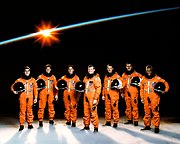STS-39
| STS-39 | |||||
 | |||||
| Uppdrag | 40 | ||||
|---|---|---|---|---|---|
| Rymdfärja | Discovery (12)[1] | ||||
| NSSDC-ID | 1991-031A[2] | ||||
| Färdens tid | 8 dagar, 7 timmar, 22 minuter, 23 sekunder | ||||
| Uppskjutning | |||||
| Startplats | Startplatta 39A vid Kennedy Space Center i Florida | ||||
| Start | 28 april 1991 7:33:14 a.m. EDT | ||||
| Landning | |||||
| Landningsplats | Runway 15, Kennedy Space Center, Fla. | ||||
| Landning | 6 maj 1991, 2:55:35 p.m. EDT | ||||
| Omloppsbana | |||||
| Varv | 133 st[3] | ||||
| Apogeum | 263 km | ||||
| Perigeum | 248 km | ||||
| Banlutning | 57,0° | ||||
| Sträcka | 5,584 miljoner km | ||||
| Besättning | |||||
| Befälhavare | Michael L. Coats (3) | ||||
| Pilot | L. Blaine Hammond (1) | ||||
| Uppdragsspecialister | Guion S. Bluford (3) Gregory J. Harbaugh (1) Richard J. Hieb (1) Donald R. McMonagle (1) Charles L. Veach (1) | ||||
 | |||||
| Kronologi Rymdfärjeprogrammet | |||||
| |||||
STS-39 var den fyrtionde flygningen i det amerikanska rymdfärjeprogrammet, den tolfte flygningen med rymdfärjan Discovery. Den sköts upp från Pad 39A vid Kennedy Space Center i Florida den 28 april 1991. Efter drygt åtta dagar i omloppsbana runt jorden återinträdde rymdfärjan i jordens atmosfär och landade vid Kennedy Space Center.
Flygningen gjordes på uppdrag av USA:s försvarsdepartement.
Se även
Referenser
- ^ NASA Space Shuttle Launch Archive Arkiverad 25 juli 2010 hämtat från the Wayback Machine., läst 28 juli 2016.
- ^ ”NASA Space Science Data Coordinated Archive” (på engelska). NASA. https://nssdc.gsfc.nasa.gov/nmc/spacecraft/display.action?id=1991-031A. Läst 18 mars 2020.
- ^ Manned Astronautics - Figures & Facts Arkiverad 22 juli 2015 hämtat från the Wayback Machine., läst 28 juli 2016.
Externa länkar
 Wikimedia Commons har media som rör STS-39.
Wikimedia Commons har media som rör STS-39.
| ||||||||
| ||||||||||||||||||||||||||||||||
Media som används på denna webbplats
Författare/Upphovsman: Pascal (Flickr user: pasukaru76), Licens: CC0
Vostok spacecraft replica at the Technik Museum Speyer, Germany.
The STS-39 crew portrait includes 7 astronauts. Pictured are Charles L. Veach, mission specialist 5; Michael L. Coats, commander; Gregory J. Harbaugh, mission specialist 2; Donald R. McMonagle, mission specialist 4; L. Blaine Hammond, pilot; Richard J. Hieb, mission specialist 3; and Guion S. Buford, Jr., mission specialist 1. Launched aboard the Space Shuttle Discovery on April 28, 1991 at 7:33:14 am (EDT), STS-39 was a Department of Defense (DOD) mission. The primary unclassified payload included the Air Force Program 675 (AFP-675), the Infrared Background Signature Survey (IBSS), and the Shuttle Pallet Satellite II (SPAS II).
STS-40 Mission Insignia
STS-37 Mission Insignia
STS-39 Mission Insignia







